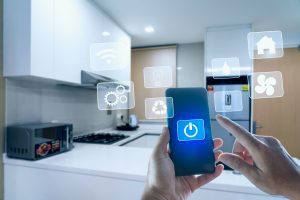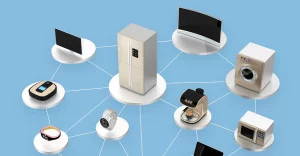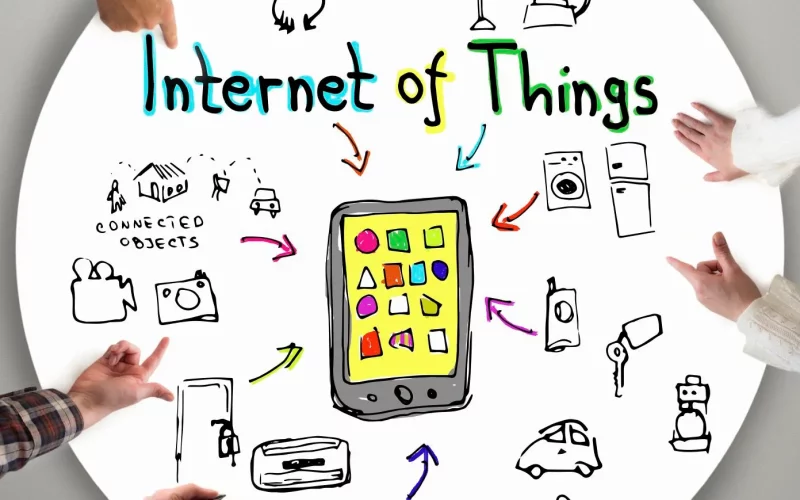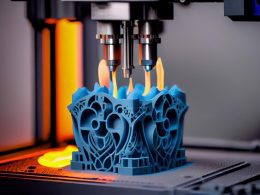The Internet of Things (IoT) is transforming the way we interact with technology, integrating devices across various sectors to optimize efficiency, security, and convenience. This comprehensive guide will explore the latest advancements in IoT, covering top consumer devices, industrial applications, edge computing integration, and much more. We’ll also dive into specific examples, benefits, and potential challenges, providing a rounded understanding of IoT’s expanding landscape in 2024.
Best IoT Devices for Smart Homes 2024

In 2024, smart home devices have reached new levels of integration, providing users with seamless control over everything from lighting to appliances. Popular devices like Amazon Echo Dot and Google Nest Hub act as central hubs for home automation, enabling users to manage multiple devices with voice commands.
Benefits:
- Enhanced Convenience: Voice-activated commands allow hands-free operation.
- Energy Efficiency: Smart thermostats like Nest save on heating and cooling costs by adapting to user patterns.
- Improved Security: Smart locks and cameras provide real-time monitoring and remote access.
IoT and AI Integration in Consumer Devices
One of the most significant shifts in IoT technology is the integration of AI, which allows IoT devices to operate more autonomously and efficiently. AI-driven IoT devices, such as smart cameras with facial recognition, are changing the security landscape.
Benefits:
- Enhanced Decision-Making: AI algorithms process large datasets in real-time, improving responses in security devices.
- Customization: AI-enabled devices learn user preferences, creating a more personalized experience.
- Predictive Maintenance: Wearables equipped with AI can alert users of health issues before they become critical.
Top IoT Connectivity Platforms for Enterprises
Connectivity is the backbone of IoT functionality. In August 2024, Oracle and AT&T partnered to create a platform that allows enterprises to streamline data from IoT devices into Oracle Cloud Infrastructure.
Benefits:
- Real-Time Monitoring: Continuous data flow enables real-time insights.
- Scalability: Enterprises can expand device connectivity without compromising performance.
- Improved Automation: Connectivity platforms allow automated responses, reducing manual interventions.
How IoT Edge Computing is Transforming Data Processing
Edge computing brings data processing closer to the source, reducing latency and improving security. By 2025, over half of IoT data will be processed at the edge, which is especially beneficial in sectors that require immediate data responses, such as healthcare and manufacturing.
Benefits:
- Reduced Latency: Processing data locally reduces the time needed to make decisions.
- Lower Costs: Less bandwidth is required, minimizing cloud processing expenses.
- Enhanced Security: Sensitive data remains closer to the source, reducing exposure.
IoT Devices for Industrial Applications in Manufacturing
Industrial IoT (IIoT) applications are becoming more advanced, with factories using IoT sensors for equipment monitoring, predictive maintenance, and supply chain optimization.
Examples:
- Smart Sensors: Used in manufacturing plants to monitor temperature, humidity, and equipment conditions.
- Automated Robots: Robots in manufacturing lines improve productivity and accuracy.
- Asset Tracking: IoT-based asset tracking provides real-time inventory insights.
Benefits:
- Efficiency Gains: Automated processes reduce downtime and human error.
- Cost Savings: Predictive maintenance decreases repair costs.
- Resource Optimization: Improved inventory tracking lowers waste.
Security Protocols for IoT Devices in 2024
As IoT devices become more widespread, securing these devices is essential to prevent unauthorized access and data breaches. Updated security protocols are crucial to protect users from cyber threats.
Benefits:
- Data Protection: Encryption protocols safeguard data during transmission.
- User Privacy: Improved authentication prevents unauthorized device access.
- Reduced Cyber Threats: Regular firmware updates and secure APIs minimize vulnerabilities.
Amazon Echo Dot Smart Home IoT Integration
The Amazon Echo Dot is one of the most popular IoT devices in smart homes. It serves as a command center for managing multiple smart home functions, including lighting, security, and even ordering groceries.
Benefits:
- Easy Integration: Works with a wide range of smart home devices.
- Voice-Controlled Automation: Simple commands allow quick task execution.
- Seamless Connectivity: Connects multiple devices under a single network.
Role of IoT in Optimizing Supply Chain Management

Supply chain management has greatly benefited from IoT devices, which enable real-time tracking, demand forecasting, and optimized inventory management.
Benefits:
- Improved Forecasting: Data from IoT devices assists in accurate demand planning.
- Enhanced Efficiency: Real-time tracking optimizes logistics and minimizes delays.
- Resource Management: Reduces overstocking and inventory holding costs.
Latest IoT Devices for Home Automation Systems
Home automation has expanded beyond smart lights and thermostats to include security cameras, doorbells, and kitchen appliances that work together for a cohesive smart experience.
Benefits:
- Enhanced Convenience: Remote management of devices through apps.
- Energy Conservation: Smart power outlets cut down energy use.
- Increased Security: Cameras and alarms keep homes safe from intruders.
Advancements in IoT Network Security
New IoT security advancements address the vulnerabilities that come with increased device connectivity. Companies are investing in network security to protect data integrity.
Benefits:
- Cybersecurity: Secure connections prevent unauthorized data access.
- System Stability: Secure networks reduce the risk of device interference.
- Reliable Firmware Updates: Regular updates enhance device resilience.
AT&T IoT Network Integration with Oracle Cloud
AT&T’s integration with Oracle Cloud exemplifies how telecom companies are enhancing IoT functionality, allowing enterprises to leverage robust cloud solutions for IoT connectivity.
Benefits:
- Streamlined Operations: Unified platform simplifies device management.
- Enhanced Data Processing: Direct cloud connection improves data flow.
- Optimized Infrastructure: Scalable for growing enterprise needs.
IoT Devices for Monitoring Environmental Conditions in Agriculture
In agriculture, IoT devices like soil sensors, climate stations, and moisture detectors improve yield by monitoring crop conditions.
Examples:
- Soil Moisture Sensors: Help farmers water fields precisely.
- Weather Stations: Collect climate data to optimize planting.
- GPS-Enabled Equipment: Streamlines field operations and management.
Benefits:
- Increased Crop Yields: Precision farming enhances productivity.
- Resource Conservation: Smart irrigation saves water.
- Data-Driven Decisions: Farmers make informed decisions based on real-time data.
Use of IoT Sensors in Traffic Management Systems
IoT-enabled traffic sensors provide insights into road conditions, vehicle density, and traffic flow. Smart traffic lights can change signals based on traffic volume.
Benefits:
- Reduced Congestion: Adaptive signals decrease wait times.
- Increased Safety: Alerts reduce accidents and manage emergencies.
- Environmental Impact: Fewer idling cars lower emissions.
Edge Computing and IoT in Healthcare Applications
Edge computing in healthcare reduces data transfer time, enabling fast responses in medical monitoring and patient management. Wearable devices can alert caregivers in real-time.
Benefits:
- Fast Data Access: Immediate responses to medical alerts.
- Enhanced Patient Monitoring: Accurate tracking of vital signs.
- Cost Efficiency: Edge processing reduces data transfer expenses.
How to Secure IoT Devices in a Smart Home Network
Securing IoT devices in smart homes involves using strong passwords, firewalls, and device updates to prevent unauthorized access.
Benefits:
- Enhanced Privacy: Secures personal data from cyber threats.
- Device Protection: Safeguards devices from being hacked.
- Peace of Mind: Users enjoy smart features without compromising security.
Smart Wearables and IoT Integration for Health Tracking

Smart wearables with IoT integration are advancing health tracking capabilities for everyday users and healthcare professionals alike. Popular devices like Fitbit and Apple Watch monitor real-time health metrics, including heart rate, oxygen levels, and even sleep quality. The collected data can be accessed on connected apps, where users can track their health trends over time.
Benefits:
- Immediate Health Insights: Real-time data empowers users to make quick, informed decisions about their health.
- Preventive Care: Alerts for abnormal heart rates or oxygen levels allow users to seek timely medical help.
- Data Sharing with Providers: Many wearables allow data sharing with healthcare providers, enhancing personalized care and chronic condition monitoring.
IoT-Enabled Predictive Maintenance in Industries
In industries such as manufacturing and energy, predictive maintenance powered by IoT sensors is transforming traditional maintenance processes. Sensors monitor equipment for signs of wear and predict potential failures before they happen, reducing unexpected downtime and maintenance costs.
Benefits:
- Cost Savings: Preventing equipment failures minimizes repair expenses and operational losses.
- Enhanced Efficiency: Predictive maintenance helps maintain steady production and avoids unexpected interruptions.
- Resource Optimization: Companies can allocate resources more effectively, reducing waste and extending machinery lifespan.
Consumer IoT Devices with Built-In AI Capabilities

IoT devices in the consumer market, such as smart TVs, refrigerators, and security cameras, are now equipped with AI that adapts to user behavior. These devices learn from user interactions and tailor their responses to provide a personalized experience. For instance, AI in smart TVs might suggest shows based on viewing history, while security cameras can differentiate between familiar and unknown faces.
Benefits:
- Personalized Experience: AI adjusts to individual preferences, enhancing usability and satisfaction.
- Increased Convenience: Devices anticipate needs and offer suggestions without user input.
- Enhanced Functionality: Adaptive learning optimizes device performance based on user habits.
Challenges in IoT Device Connectivity and Network Management
While IoT devices offer significant benefits, their reliance on network connectivity can lead to disruptions. Connectivity issues, data bottlenecks, and interoperability problems across various devices and platforms can affect performance. This highlights the importance of robust network management solutions that ensure seamless connections, data flow, and security.
Key Challenges:
- Network Congestion: With multiple devices connected, data traffic can become overwhelming.
- Security Risks: Weak network management can expose devices to cyber threats.
- Interoperability Issues: Different device manufacturers and platforms may have compatibility issues, complicating integration efforts.
How IoT is Reshaping Home Security Systems
IoT is enhancing home security with devices like the Ring Video Doorbell, Arlo cameras, and smart locks that can be managed remotely. These systems offer real-time alerts, motion detection, and live video streaming to the user’s smartphone, giving homeowners peace of mind even when they’re away. Integration with voice assistants like Alexa further boosts convenience by enabling voice-activated security controls.
Benefits:
- Remote Access: Homeowners can monitor and manage security from anywhere.
- Instant Alerts: Real-time notifications help respond quickly to unusual activity.
- Seamless Integration: Smart locks, cameras, and alarms work together in a cohesive system.
Future of IoT and AI in Edge Device Automation
As IoT and AI evolve, edge devices—like sensors and gateways—are expected to perform more autonomous actions without needing centralized control. This trend is significant in fields like healthcare, where edge devices can instantly process patient data and alert caregivers, or in smart cities, where they can manage traffic flow independently.
Benefits:
- Reduced Latency: Processing data locally allows for faster response times.
- Increased Reliability: Fewer centralized dependencies make systems more resilient.
- Enhanced Autonomy: Edge devices can handle routine tasks independently, freeing up human resources for more complex responsibilities.
Impact of IoT on Energy Management in Smart Buildings
IoT devices in smart buildings play a critical role in energy efficiency. Smart HVAC systems, lighting, and occupancy sensors adjust based on real-time data, minimizing unnecessary energy usage. For instance, HVAC systems may automatically adjust based on occupancy or external weather conditions, while lighting systems can turn off when no one is in the room.
Benefits:
- Reduced Energy Costs: Optimized energy usage lowers operational expenses.
- Sustainability: Minimizing energy waste supports environmental goals.
- Improved Comfort: Smart buildings adjust to user needs, enhancing occupant comfort and productivity.
Each of these sections demonstrates how Internet of things are being applied across sectors to drive innovation, streamline processes, and address everyday challenges. The integration of AI with IoT, advancements in predictive maintenance, and enhanced energy management are some of the most impactful changes in IoT today, presenting both opportunities and challenges as the technology evolves.
Conclusion
The future of IoT is bright, with advancements in connectivity, AI integration, and edge computing transforming how we live and work. Whether through smart home devices or industrial applications, IoT technology is providing tangible benefits across sectors, from cost savings and efficiency to enhanced security and user experience. As we continue to adopt and integrate these devices, maintaining robust security protocols and connectivity management will be critical for sustained growth and user trust in IoT technology.












